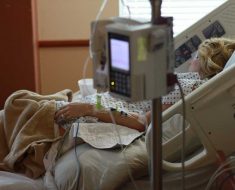Dear Mayo Clinic: Is restless legs syndrome hereditary? Is there an effective treatment, or does a diagnosis of RLS mean I will have it for life?
A: Restless legs syndrome (RLS), is not always hereditary. But it does run in some families, and several genetic links have been found for RLS. While restless legs syndrome is most often a chronic condition, treatment is available that often can effectively control its symptoms.
Restless legs syndrome is a condition characterized by an unpleasant or uncomfortable urge to move your legs. Some people describe it as a crawling, pulling or burning sensation in their thighs, calves or feet. The sensation is temporarily relieved when you get up and move around, especially by walking, or when you shift or stretch your legs. RLS symptoms typically begin after you have been sitting or lying down for some time. Symptoms also tend to get worse in the evenings and at night, and are less bothersome during the day.
In many cases of RLS, the cause is unknown. But RLS appears to be hereditary in about half the people who have it. Several specific gene variations have been associated with this disorder. Familial RLS symptoms often begin earlier in life—usually before age 40—than they do in forms of the disease that are not hereditary.
In some cases, RLS may be related to another underlying medical condition. For example, some people with symptoms of RLS are found to have iron deficiency. In these situations, taking iron supplements may eliminate symptoms of restless legs syndrome.
Treatment for RLS usually focuses on relieving the symptoms. A variety of simple steps you can take at home may help. Taking a warm bath, massaging your legs, applying warm or cool packs, and trying relaxation techniques, such as yoga or meditation, can all be useful in calming RLS. Exercising at a moderate level on a regular basis and establishing good sleep habits can help, too. For some people, caffeine, alcohol and tobacco can trigger RLS symptoms or make them worse. You may want to try cutting back on these substances to see if your symptoms lessen.
If lifestyle changes are not enough, your doctor may prescribe medication to reduce leg restlessness. Medications that have been shown to be helpful for RLS include several that affect a chemical in your brain called dopamine. Dopamine’s job is to send messages that control muscle movement from your brain to your body. Researchers suspect that RLS may be linked to an imbalance in dopamine.
Using drugs that stimulate dopamine receptors in the brain, such as ropinirole, pramipexole or rotigotine, can help control RLS symptoms. Side effects of dopamine medications, however, may include nausea, sedation or, rarely, certain compulsive behaviors such as shopping or gambling. Caution and long-term follow-up for the use of these medications is necessary.
Certain medications used to treat painful nerve conditions and epilepsy, such as gabapentin, also may effectively treat RLS. Other prescription drugs, including opioid analgesics, muscle relaxants and sleep medications, are sometimes used to help combat RLS symptoms as well.
Be aware that certain medications can make RLS symptoms worse, including some antidepressants and antinausea drugs. Review with your doctor a list of the medications you are currently taking. Your doctor may recommend substitutes, as needed, to help manage RLS.
Source: Read Full Article





